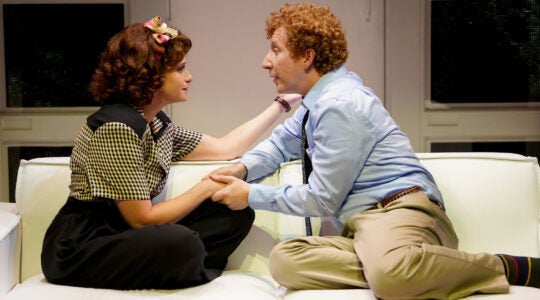For Broadway producer Stuart Oken, there are few career moments as transformative as receiving an invitation from the Gershwin family. A lifelong fan of Gershwin’s standards and symphonic works, Oken jumped at the opportunity for a meeting where he was asked to adapt the 1951 film, “An American in Paris,” into a Broadway musical. However, as a producer specifically of new musicals, Oken was hesitant about developing a show that “felt like a revival”; in other words, that it felt old. Adding to that was the film’s vague storyline and tenuous historical context.
“An American in Paris” is ostensibly, he says, “the story of an end of a war and a group of people repurposing their lives in a devastating time.” But the film evaded its subject matter “by setting it in 1950 and making it in a backlot Hollywood environment. They took away anything authentic about the war.” If Oken agreed to produce the musical, he would have to find a way to make it new. And for Oken, the “new” element would be a more honest reckoning with history.
When “An American in Paris,” the musical, opens at the Palace Theatre on April 12, it will be more than 63 years after the film premiered, and more than 86 years after George Gershwin debuted his eponymous composition at the New York Philharmonic. In response to a commission from the conductor Walter Damrosch in 1928, Gershwin submitted a symphonic poem that captured his experiences on the streets of Paris during an extended visit that year. The piece, which he titled, “An American in Paris,” presented shifting musical motifs to demarcate his experiences in a foreign city. In the opening measures, Gershwin wrote, a visitor “absorbs the French culture,” followed by “rich blues” representing an episode of homesickness, and ultimately a conclusion in which “the street noises and French atmosphere are triumphant.”
The film, “An American in Paris,” produced more than two decades later and directed by Vincent Minnelli, situates the narrative at the end of World War II. At the start of the film, Gene Kelly’s character delivers his opening lines in voiceover: “This is Paris. And I’m an American who lives here. My name is Jerry Mulligan and I’m an ex-GI.” Choreographed by Kelly himself, the movie is the love story of Jerry and a French girl named Lise (Leslie Caron) set against a Technicolor background resembling Paris and featuring Gershwin’s 1928 composition, here presented as a lengthy ballet sequence that has become the most lauded part of the movie. (The film won six Academy Awards including Best Picture.)
For Oken, who has shepherded the new musical since its inception and holds the title of lead producer, the challenge in adapting this “perfect yet imperfect” film meant rewriting the script as a more complex narrative and finding a director who would make that vision come alive with the right performers. Oken signed Craig Lucas, a prolific playwright who collaborated on the 2003 Broadway musical “The Light in the Piazza,” as the book writer. In selecting a director, Oken felt that dance, being an essential narrative device in the story, necessitated a singular director/choreographer, particularly one who understood ballet. He took a risk and reached beyond the world of theater to venerated ballet choreographer Christopher Wheeldon.
Wheeldon’s role as director would be to tell the story through dance, dialogue and song as the film does, and, transcending the parameters of the film, to convey the emotional toll of the occupation and the Holocaust. Just as ambitiously, he would need to reveal, through his characters, the healing power of art.
The creative team, including Wheeldon, Oken and Lucas, began by exploring each character’s circumstance and backstory. More specifically, they had to determine why each is in Paris at the start of story. Their decision to shift the year backward to 1945, a handful of years earlier than the film, proved subtle but significant. The occupation of Paris had just ended and there was an immediate sense of rebirth for Parisians able to see French flags displayed where Nazi ones had recently flown.
The American GI, Jerry, has just been discharged from military service and, feeling psychologically unprepared to return home, decides to stay in Paris and attempt to make money as a painter, his passion before the war. Lise is a Jewish-French girl who has lived in hiding during the war with a compassionate French family, the Baurels, whose son Henri has become a close companion to her. Both of Lise’s parents were killed — a detail that is glossed over in the film. Henri and Jerry are both attracted to Lise, as is Adam Hochberg, a Jewish-American composer who was injured in the war, and like Jerry, has stayed in Paris hoping to find income as an artist.
The songs these characters sing — “S’Wonderful,” “I’ve Got Rhythm” and “Our Love is Here to Stay” — are still joyous, but in this production, the characters reach out for empathy more than entertainment.
As Wheeldon sees the central narrative, “Lise yearns for true love; this yearning partly comes from a place of deep sadness over the loss of her parents. She is expected to marry Henri, whose family has protected her through the occupation, but she feels real passionate love for Jerry. Jerry yearns for true love also; he and Lise connect over their desire to leave the war behind them.”
Wheeldon’s insight into the musical comes with experience. In 2005 he choreographed the ballet from “An American in Paris” for the New York City Ballet. He also choreographed an earlier musical adaptation, written by the late playwright Wendy Wasserstein and directed by Sir Nicholas Hytner. But, according to Oken, the work never got to a place that satisfied the creative team. The current version is Wheeldon’s first attempt at directing a Broadway musical and his lead actors are theater newcomers as well: Leanne Cope (Lise) is a First Artist with the Royal Ballet, and Robert Fairchild (Jerry) is a principal dancer with the New York City Ballet.
The challenge for Wheeldon has been daunting but exhilarating. “I discovered that like most things in life, jumping in at the deep end is a great way to learn fast,” he says. “I tell stories in movement and have to find the right dance vocabulary to do that. In book scenes, the words are there already so it becomes about finding truth in the moment.”
In casting the show, Oken knew that Wheeldon would need “true quadruple threats [acting, singing, dancing, and pointe] and it would be easier to find people in the world of ballet who can sing and act as opposed to finding a theater actor who has training in ballet.”
Considering another challenge in the creative process, Oken wondered if audiences might have “Gershwin fatigue.” After all, Gershwin’s “Porgy and Bess” ran in 2012, as well as did another musical called “Nice Work If You Can Get It” that featured Gershwin songs. But as “An American in Paris” came together, and especially following the positive reception it receive in Paris, he has become more confident in its prospects for Broadway success. At the world premiere this winter at Théâtre du Châtelet in Paris, critics and audiences were rapturous. Sarah Crompton at the Telegraph wrote, “this is emphatically not a stage version of the much-loved 1951 film but a thorough-going rethinking.”
The soon-to-open production brings the buzz of advance critical praise combined with the audience-pleasing timelessness of a Rodgers and Hammerstein musical. In fact, the stage version of “An American in Paris” has much in common with shows like “South Pacific” and “The Sound of Music,” says Oken. There is the clash of two cultures, the experience of a foreign country, and the emergence of national identity. “So what happens,” he says, “is you tell personal stories set against larger landscapes.”
The New York Jewish Week brings you the stories behind the headlines, keeping you connected to Jewish life in New York. Help sustain the reporting you trust by donating today.




